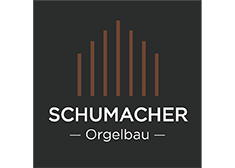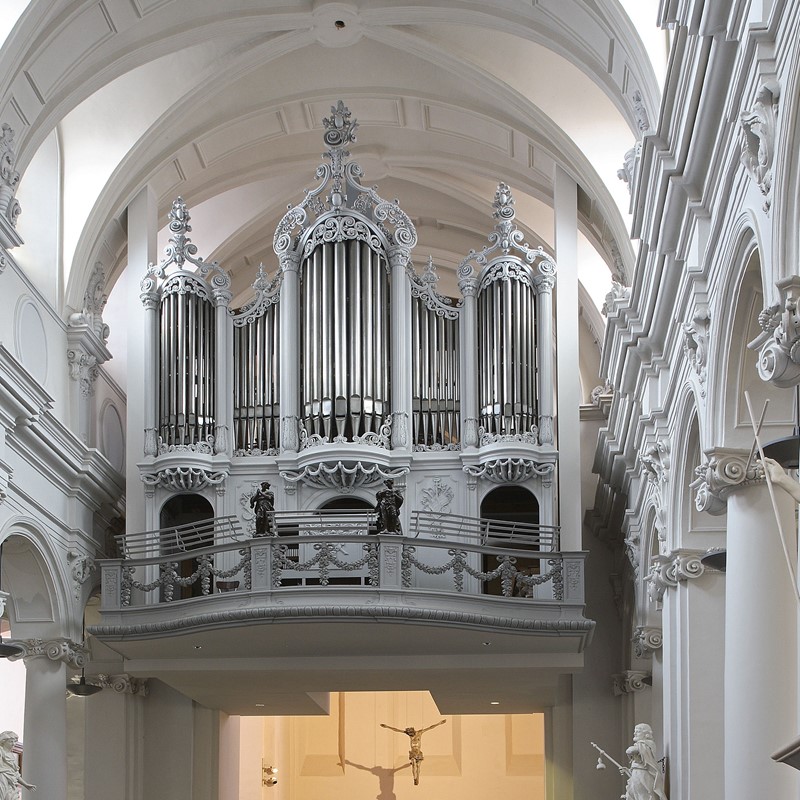Liège (B) | Saint Bartholomew
Prior to the installation of the Merklin organ the Collégiale Saint-Barthélemy in Liège possessed another instrument of ancient origins. Its case dated back to the middle of the 16th century. The organ was dismantled and adapted by Merklin in order to be reinstalled in Quenast.
Joseph Merklin, who had completed his apprenticeship in the workshops of Walcker in Ludwigsburg, arrived to Belgium while he was working in Stavelot for the Korfmacher Company from Linnich. In 1843 Merklin decided to go on his own and installed his workshop in Brussels. In these headquarters he elaborated two consecutive proposals for Saint-Barthélemy, probably competing with Dreymann from Mayence and with Clerinx. The parish took great care in evaluating the competitor’s proposals and finally, after lengthy deliberations, awarded Merklin with the contract for building a new 30-stop two-manual organ. As the instrument gained shape in the shop, Merklin proposed numerous changes and additions, but he found only partial acceptance among the Parish members. Those received with favour were the addition of a third manual Echo Expressif, a pneumatic lever machine and a series of hitch-down pedals for the reeds. The organ was dedicated on the 7th of January 1852 by the organist Petitpierre from Neufchâtel.
Between 1883 and 1887 Pierre Schijven renovated the organ completely: new console, new action, new winding system and refurbishment of the pneumatic lever. Off-contract he also renovated the chest of the third manual and added a Voix céleste.
In 1928 Emile II Kerkhoff performed some repairs just before Delmotte, only 6 years later, intervened with a revoicing and the replacement of various wooden pipes. The instrument was finally disassembled by Marc Leuridan in 1976 and stored in the church when a vast restoration-renovation of the building began. This project was completed 30 years later in 2006 under the direction of the well reputed architecture bureau Hautecler-Dumont from Liège. The organist L. Devos was entrusted with the compilation of the first scope statement of the organ restoration project and the Schumacher Company was given the delicate task of executing it.
The project aims at the preservation and restoration of the Schijven organ with only one significant modification and a few minor specification adaptations. The Echo chest - placed lengthwise by Schijven due to assembly inconveniences – was turned 90° on its centre axle and repositioned sidewise, so in line with the other chests and favouring sound egress. This was made possible by the construction of a new balcony under the last span of the nave.
The musical concept sought after was pretty much that of Merklin from the middle of the 19th century, which is of particular interest because it incarnates that critical turning point from the post-classicism into the romanticism. The instrument reflects the rejuvenating process suffered by the organ building business in Belgium at a time when numerous foreign aesthetics, primarily from Germany and France, began to influence local taste. Since the assessment of the original pitch proved to be impossible, we decided to retain the pitch used by Merklin in his contemporary installation for the Van Celst Institute in Antwerp, unaltered and tuned at 441 Hz. This also rendered unnecessary any radical intervention to the ranks predating Schijven thus assuring closest resemblance to the original concept.
Stop list
Grand-Orgue
C - g '''
Principal 16'
Montre 8'
Viole de Gambe 8'
Flûte 8'
Bourdon 8'
Flûte 4'
Prestant 4'
Nasard 2 ⅔'
Doublette 2'
Cornet V
Fourniture IV-V
Trompette 16'
Trompette 8'
Clairon 4'
Positif
C - g '''
Bourdon 16'
Montre 8'
Bourdon 8'
Salicional 8'
Voix céleste 8'
Prestant 4'
Flûte traversière 4'
Flageolet 2'
Plein Jeu
Trompette 8'
Euphone 8'
Echo expressif
C - g '''
Dolce 8'
Bourdon 8'
Cor de chamois 8'
Fugara 4'
Flûte 4'
Cornet II - III
Basson-Hautbois 8'
Voix humaine 8'
Pédale
C - f '
Violon 16'
Soubasse 16'
Flûte 8'
Bourdon 8'
Bombarde 16'
Trompette 8'
Clairon 4'

